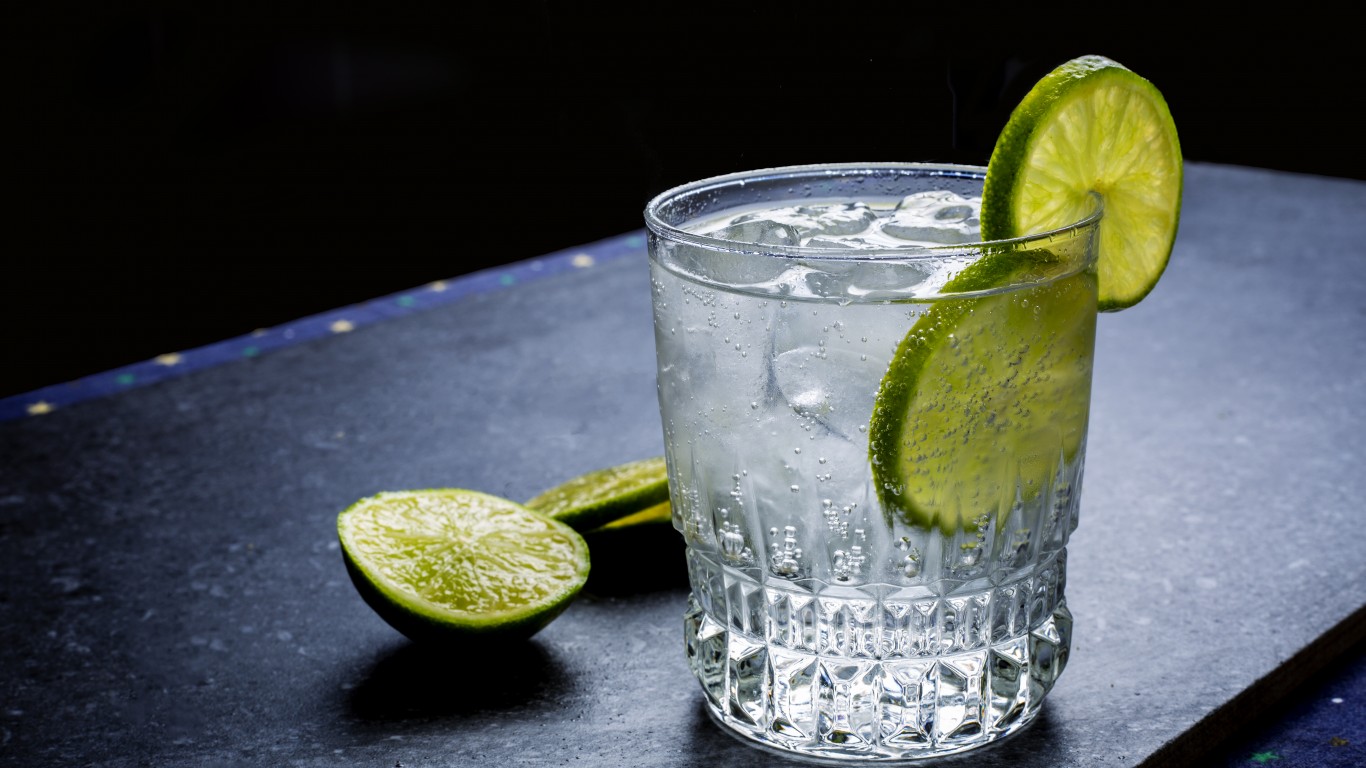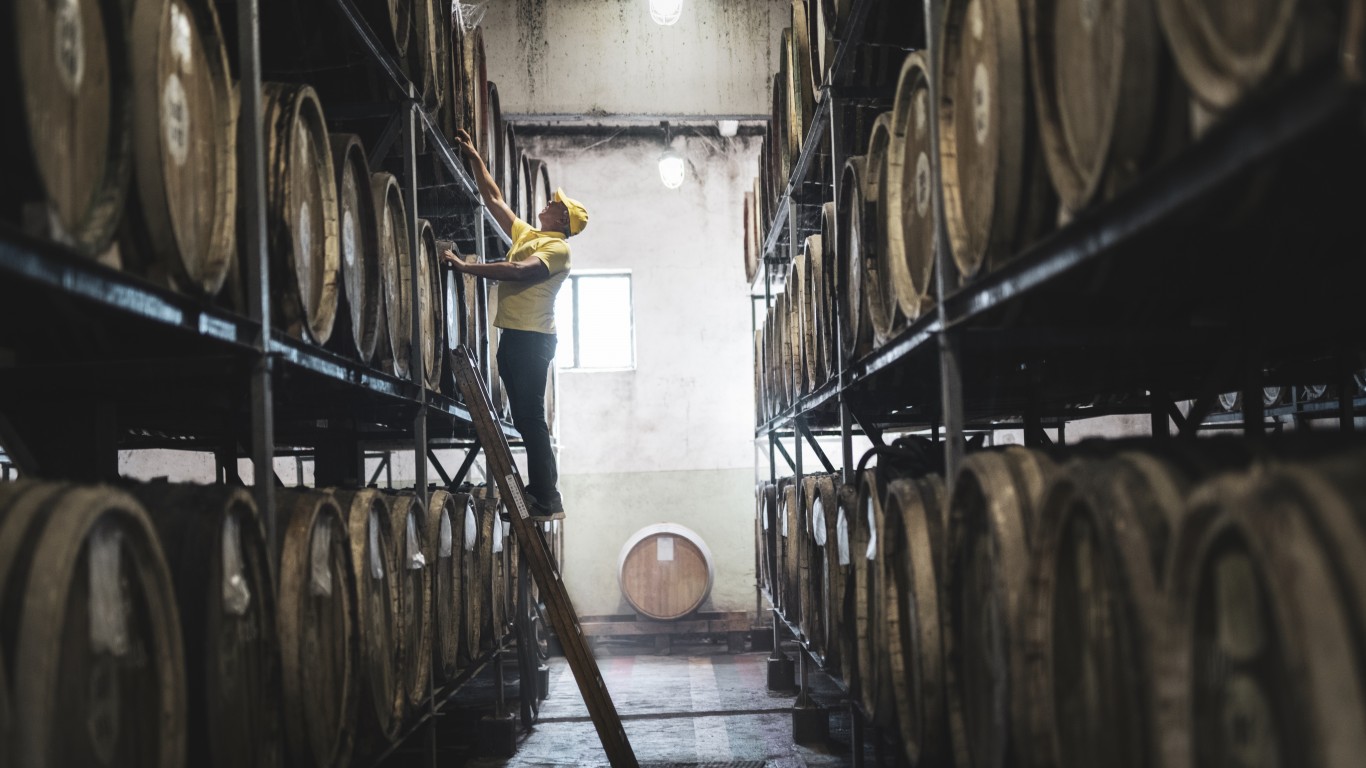
Ahhh, Vodka. Even the worst out there gets the job done, but if you’re going to be classy about it, it’s probably worth it to know what sorts of brands to avoid. Whether you’re trying to impress your houseguests with an “oh-so-curated” liquor cart or just want to level up your vodka-drinking experience, there are certain vodka brands you may do well to stay away from. Let’s take a look at the vodka brands to avoid and learn a little about what makes vodka great in the first place!
To compile this list, 24/7 Wall Street used resources from a few well-versed drinkers, notably those on liquor-tasting sites like Tasting Table. Additionally, we compared the process and quality of the products (via things like distillation) to determine if the price tag matches the cost. If that were misaligned, that brand wouldn’t be a great value. Let’s get started.
1. Burnett’s Vodka

Burnett’s has a bit of a reputation among colleges. First, if you are ever running low on gas, drop a handle in your Civic and hear it purr. Second, it has so much bite it might as well have teeth. It’s often referred to as “paint thinner” or “sanitizer,” but for good reason; it’s usually less than $12 in the United States.
Look, we understand the use-case for a product like this (cleaning your lawn mower blades, disinfecting a wound, etc.), but if you are looking for a quality product, this probably isn’t the move. There are some flavor options, making this a viable mixer for someone looking to make a LOT of cheap drinks, but for only a few dollars more, there are also some options that are better suited for someone who wishes to remain functional the next day.
2. Ciroc

Ciroc is a bit of a tricky one but has ended up on this list nonetheless. It really had its heyday around 10 years ago when it was the go-to club drink, and every commercial featured a glistening bottle between two babes, but times have changed. Still, to this day, it’s generally regarded as a more luxury vodka option, but most of that price tag comes from its marketing. Combs helped to solidify the brand as an icon, however, and it really isn’t bad; it’s just a little overrated for what it is.
The differentiating factor with Ciroc is that it’s made with grapes instead of potatoes or grain, giving it a sweeter taste than many others. Although not necessarily a con, this does limit it as a mixer and change the sorts of drinks that you would ideally use it for as a vodka.
3. Karkov

Karkov is another college-fueled specialty similar to Burnett’s. While Ciroc may be a decent vodka inflated by marketing, Karkov doesn’t shy away from what it is: cheap and available from “that one store where he doesn’t ID you.” The name is a bit sneaky, as one might think that Karkov is actually Russian, but it isn’t. Karkov is from a distillery in Minnesota, which helps keep its price so low.
Again, similar to Burnett’s, the fuel-taste isn’t our favorite, and if you are going to spend $11 on bad vodka, you might as well spend $15 on decent Vodka. Also, it’s apparently nick-named “Karcrash,” so yeah.
4. Grey Goose

We would place Grey Goose along with Ciroc, mainly in the regard that it’s a well-marketed product that derives its high price from its name and not necessarily its product. To be clear, Grey Goose isn’t a bad vodka, but it’s usually the first “luxury” vodka that someone tries and thinks, “Wow, there actually is a difference when you spend a little more.” That being said, the difference with Grey Goose is price-in a little much.
Grey Goose is only distilled once, something that most other brands do 2-4 times before letting it hit shelves. Additionally, it was created with the intention of differentiating itself in the market due to its price and marketed as being made in France (because France is known for luxury products). It worked. It’s a totally fine liquor, but if you are going to spend nearly $50 for a bottle, you can do a lot better.
5. Skyy

Skyy is a weird vodka. It isn’t as low-budget as Karkov or Burnett’s, but seeing blue bottles on the kitchen island at a party while you try and convince yourself that “no, I’m totally fine right now” is a formative experience. It’s the classy cousin that sometimes shows up to parties, but they wore something a little garish, and as you’ve matured, you don’t want to be associated with them anymore.
Skyy is produced in California in the United States. It uses grain as its main ingredient, something pretty common across vodka brands. That being said, Skyy is known to have a bad taste when it hits room temperature and is only palatable when chilled.
6. Outskirts

Outskirts is a mid-priced vodka brand produced in Texas in the United States, but it’s particularly sold in certain stores. As explained by Tasting Table, the process to create the vodka is fine, but the starting point is flawed. Outskirts uses American corn as their primary grain of choice, then it goes through a six-step distillation process.
Sounds good, right? Well, no. Unfortunately, the process was bound to fail because Outskirts uses a not-so-great water supply, and no amount of filtering seems to be able to remove the bad taste.
7. UV Vodka

UV Vodka is our final low-tier vodka on the list that should be avoided primarily because of its price and quality. First, the tip-off that really sets the tone for UV is that it comes in a plastic bottle. Generally speaking, drinking 40% ethanol from a plastic bottle isn’t something that anyone should be proud of. Besides the visual implications, there are material differences. Plastic reduces costs, but it has an impact on shelf life and taste since air is able to penetrate plastic much easier.
There are some fun flavors from UV, so maybe just hide it in your closet and only drink it when nobody is around—just like grandma taught ya.
8. Crystal Head

There’s a trend appearing in our list. Vodkas you should avoid are either extremely low-quality or are marketed in a way that their price doesn’t justify what you get. Crystal Head is maybe the most direct example of this.
The marketing strategy for Crystal Head is quite clear (crystal, even). Make sick packaging that grabs your attention and is cool enough to be a prominent feature of your bar. To that end, mission accomplished. The results of such marketing, however, are unfortunate. Generally, Crystal Head costs around $70 for a 750mL container, marking it as one of the most expensive options at your liquor store. It certainly isn’t worth that, despite the marketing terms used to describe it (Herkimer diamond-filtered, pristine Newfoundland water, etc.).
Take Charge of Your Retirement In Just A Few Minutes (Sponsor)
Retirement planning doesn’t have to feel overwhelming. The key is finding expert guidance—and SmartAsset’s simple quiz makes it easier than ever for you to connect with a vetted financial advisor.
Here’s how it works:
- Answer a Few Simple Questions. Tell us a bit about your goals and preferences—it only takes a few minutes!
- Get Matched with Vetted Advisors Our smart tool matches you with up to three pre-screened, vetted advisors who serve your area and are held to a fiduciary standard to act in your best interests. Click here to begin
- Choose Your Fit Review their profiles, schedule an introductory call (or meet in person), and select the advisor who feel is right for you.
Why wait? Start building the retirement you’ve always dreamed of. Click here to get started today!
Thank you for reading! Have some feedback for us?
Contact the 24/7 Wall St. editorial team.

